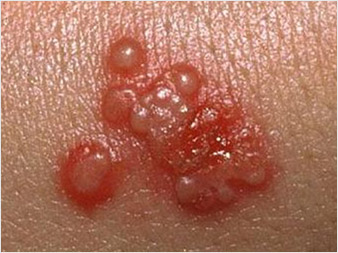* Due to the herpes simplex virus type II in genital tropism. The in utero contamination risk is rare (when primary herpetic infection).
The consequences of this infection may result in abortion, congenital disease (intrauterine growth retardation “IUGR,” hepatitis, microcephaly, hydrocephalus, intracranial calcifications, prematurity);
* In most cases this is achieved by neonatal contamination during childbirth must ascending path after rupture of membranes or the passage of the fetus through the birth canal.
The achievement may be neurological, skin and eye
* Situations risk of fetal infection is any primary infection during pregnancy (major risk: 50%), any episode of recurrence during pregnancy (medium risk: 5%), history of genital herpes in couple (0.1%).
Factors increasing the risk of neonatal infection are the primary infection in the last 3 weeks of pregnancy, pre-maturity, rup-ture of membranes and long opening of the egg, invasive procedures.
* If history of genital herpes, consider treatment with oral acyclovir 200 mg x 4 / day from the 36th SA.
In case of primary infection in the month before the birth we can propose a systematic cesarean or treatment with acyclovir and extraction vaginally after verification of the negativity of the last samples.
In case of recurrence in the week before the birth proposes a aciclovir treatment with vaginal treatment decision, if the last samples are negative or systematic cesarean section.
In case of suspected genital lesion at the time of delivery => Caesarean section.
Use of aciclovir before Q3 should be avoided unless clearly needed.
The benefits of caesarean section, when this information is asked persist if the membranes are intact or broken for less than 4 hours.
Beyond 6 hours of rupture, vaginal delivery is indicated with chemoprophylaxis with aciclovir, occlusive dressings on lesions away from the vulva, disinfection with iodine products (Betadine).
Whatever the birthing skin disinfection mode newborn Betadine, aciclovir eye use.
NB: oral herpes (HSV1) is as formidable as genital herpes vis-à-vis the child.
OTHER INFECTIOUS DISEASES:
* Hepatitis B: B virus transmission to the child is more common in late pregnancy (blood-placenta), childbirth (maternal blood and genital secretions) and the first months of life (overcrowding, hygiene life and breastfeeding), especially if the patient is HBe Ag positive.
The risk is that the child develops a chronic infection (60% of cases) with a ¼ cases a progression to cirrhosis and liver carcinoma (10% of cases).
The systematic search for HBsAg during the 3rd quarter is mandatory.
Serovaccination is indicated in children at risk.
Breastfeeding is against inappropriate.
* Cytomegalovirus: Some ultrasound images are evocative (microcephaly, IUGR, HPM-SPM, ascites, intracranial calcification leukomalacia).
The infection risk is greater in the case of primary infection; fetal passage is not systematic; fetal damage are usually benign.
* Syphilis Treponema does not cross the placenta that from 16-20 SA.
Moderate neonatal congenital syphilis has pallor, stagnation of the weight curve, hepatosplenomegaly, jaundice, ADP, maculopapular rash, and purulent and hemorrhagic bilateral coryza.
The systematic radiography entire skeleton shows images of osteochondritis.
Late syphilis develops after the age of 2 (or later) with ocular manifestations, auditory, and bone and joint.


Leave a Reply